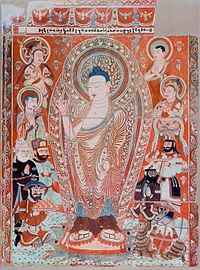Ilgecism: Difference between revisions
Toothbrush (talk | contribs) No edit summary |
Toothbrush (talk | contribs) No edit summary |
||
| (24 intermediate revisions by 2 users not shown) | |||
| Line 1: | Line 1: | ||
{{WIP}} | |||
{{Ilgecism}} | {{Ilgecism}} | ||
[[Category:Ilgecism]] | [[Category:Ilgecism]] | ||
'''Ilgecism''' is one of [[Sunalaya|the world]]'s largest religions, primarily practiced within [[Mahaborei]]. It is one of the newest monistic religions in [[Sunalaya|the world]], created in the 10th Century by [[Magtal Khan]]. The faith is monotheistic - believing there is a pure form of the divine known as the Beloved, who manifests Himself into multiple pure forms, similar to {{wp|Angel|angels}}, which are known as asuras. All finite forms come as a synthesis of these various forms. Consciousness comes because the finite forms of him love the Beloved, as He loves himself and wants His people to understand His own infinity. Consequently, the faith believes He exists in a trinity, as He is Beloved, Lover, and Love; but Love is not Lover, Beloved is not Love, and so on. | |||
Ilgecism is unique compared to other monotheistic faiths, as they believe unification with the Beloved is impossible. Instead, one must seek spiritual liberation and [[Redemption (Ilgecism)|redemption]] by understanding their own relationship with the Beloved through education about the Beloved through the Scriptures, emulating His grace and the works of His {{wp|Prophet|Manifestations}}, and doing good works. The exact means to reach spiritual liberation are hotly debated and have led to the formation of hundreds of schools. The two major schools are organized around the branches of [[Achanaha Ilgecism]] and [[Getelgel Ilgecism]]. Achanaha Ilgecism believes that the proper relationship to understand the Beloved is given by the emperor, whose communion with Him allows him to learn the traditions for social harmony and spirtual liberation. Getelgel Ilgecism believes that the proper relationship is found through personal revelation with the [[57 Great Poems]], aid through the nine [[Yrnek|Yrneks]], and through rejection of [[Ordog-Khan]], the fallen asura of [[Lust (Ilgecism)|Lust]]. Followers of the faith derive all revelations from the [[57 Great Poems]], a series of vague―yet beautiful―poems over reality, love, and the nature of the Beloved. | |||
The faith originated from a minor khan of the [TBD clan], known as the Magtal Khan, who would go on to unite various petty tribes under the Ilgec faith. His alliance would go on to found the [[Magtal Khaganate]], which, over several generations, would unite the steppes through either alliances or submission into the Khaganate. During his conquests, he would peacefully convert the local peoples. In many lands, converts mostly kept to worshipping their own idols, but recognizing them as part of the Greater Absolute. This vast period of expansion saw several religious scholars transcribe the 57 Great Poems, a series of poems that inquire about the nature of the Beloved, to help belivers understand the Beloved and His love. The Magtal Khaganate would go on to spread Ilgecism through missionary efforts and built vast {{wps|stupa|stupas}} and {{wp|pagoda|pagodas}}, many of which still stand today. | |||
When the Khaganate split, two of Magtal's feuding siblings would create the [[TBD Schism|two major branches of the faith]]. | |||
==Trinitarianism== | |||
==Rituals and Traditions == | |||
==History== | |||
==Schools== | |||
==Population== | |||
==Notes== | |||
{{Mahaborei topics}} | |||
Latest revision as of 01:24, 22 June 2020
This article is incomplete because it is pending further input from participants, or it is a work-in-progress by one author. Please comment on this article's talk page to share your input, comments and questions. Note: To contribute to this article, you may need to seek help from the author(s) of this page. |
| Part of a series on |
| Ilgecism |
|---|
 |
Ilgecism is one of the world's largest religions, primarily practiced within Mahaborei. It is one of the newest monistic religions in the world, created in the 10th Century by Magtal Khan. The faith is monotheistic - believing there is a pure form of the divine known as the Beloved, who manifests Himself into multiple pure forms, similar to angels, which are known as asuras. All finite forms come as a synthesis of these various forms. Consciousness comes because the finite forms of him love the Beloved, as He loves himself and wants His people to understand His own infinity. Consequently, the faith believes He exists in a trinity, as He is Beloved, Lover, and Love; but Love is not Lover, Beloved is not Love, and so on.
Ilgecism is unique compared to other monotheistic faiths, as they believe unification with the Beloved is impossible. Instead, one must seek spiritual liberation and redemption by understanding their own relationship with the Beloved through education about the Beloved through the Scriptures, emulating His grace and the works of His Manifestations, and doing good works. The exact means to reach spiritual liberation are hotly debated and have led to the formation of hundreds of schools. The two major schools are organized around the branches of Achanaha Ilgecism and Getelgel Ilgecism. Achanaha Ilgecism believes that the proper relationship to understand the Beloved is given by the emperor, whose communion with Him allows him to learn the traditions for social harmony and spirtual liberation. Getelgel Ilgecism believes that the proper relationship is found through personal revelation with the 57 Great Poems, aid through the nine Yrneks, and through rejection of Ordog-Khan, the fallen asura of Lust. Followers of the faith derive all revelations from the 57 Great Poems, a series of vague―yet beautiful―poems over reality, love, and the nature of the Beloved.
The faith originated from a minor khan of the [TBD clan], known as the Magtal Khan, who would go on to unite various petty tribes under the Ilgec faith. His alliance would go on to found the Magtal Khaganate, which, over several generations, would unite the steppes through either alliances or submission into the Khaganate. During his conquests, he would peacefully convert the local peoples. In many lands, converts mostly kept to worshipping their own idols, but recognizing them as part of the Greater Absolute. This vast period of expansion saw several religious scholars transcribe the 57 Great Poems, a series of poems that inquire about the nature of the Beloved, to help belivers understand the Beloved and His love. The Magtal Khaganate would go on to spread Ilgecism through missionary efforts and built vast Template:Wps and pagodas, many of which still stand today.
When the Khaganate split, two of Magtal's feuding siblings would create the two major branches of the faith.
